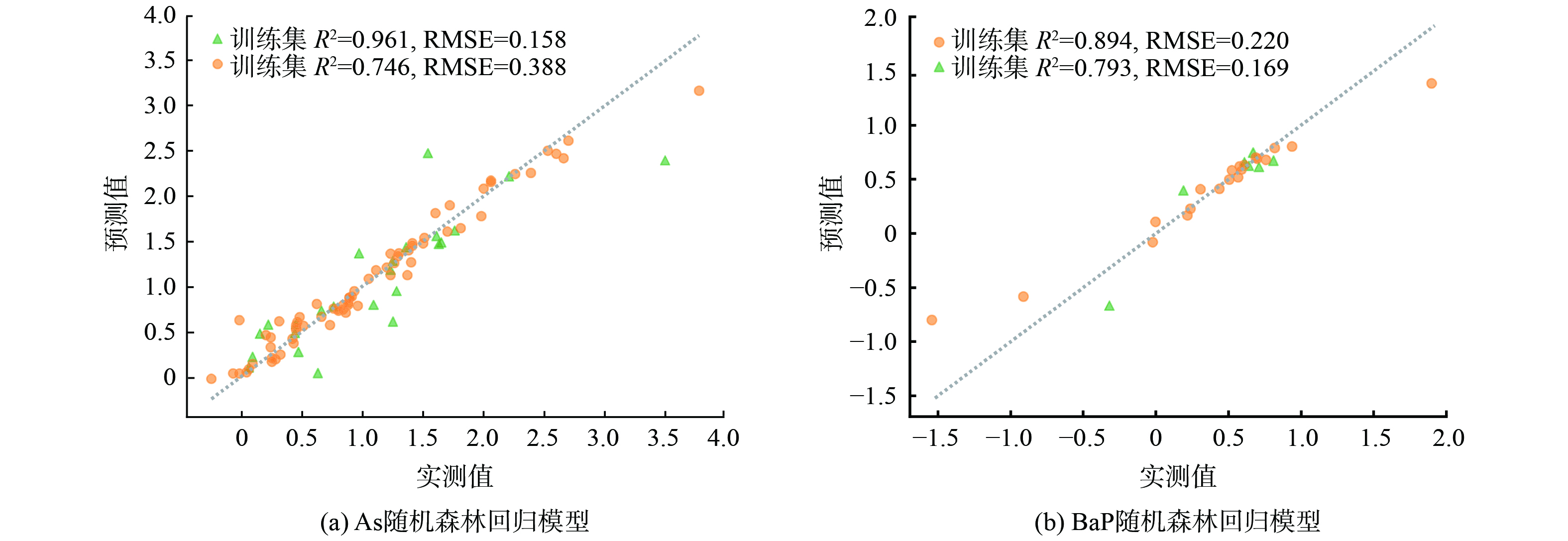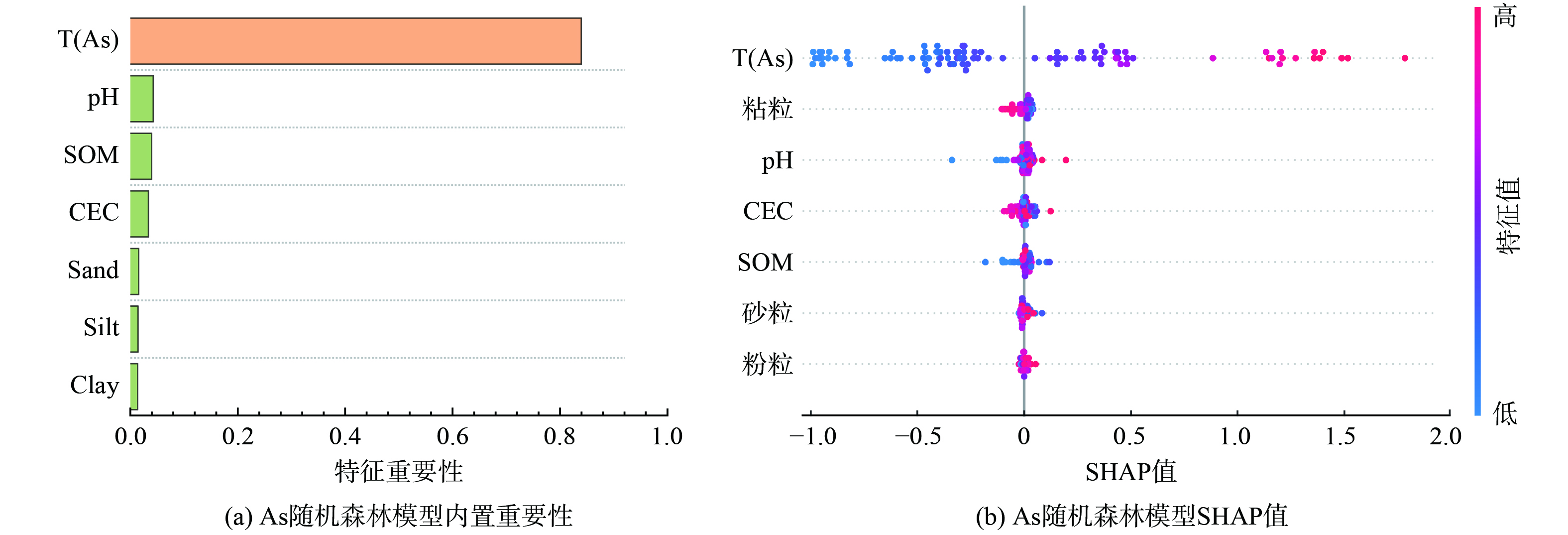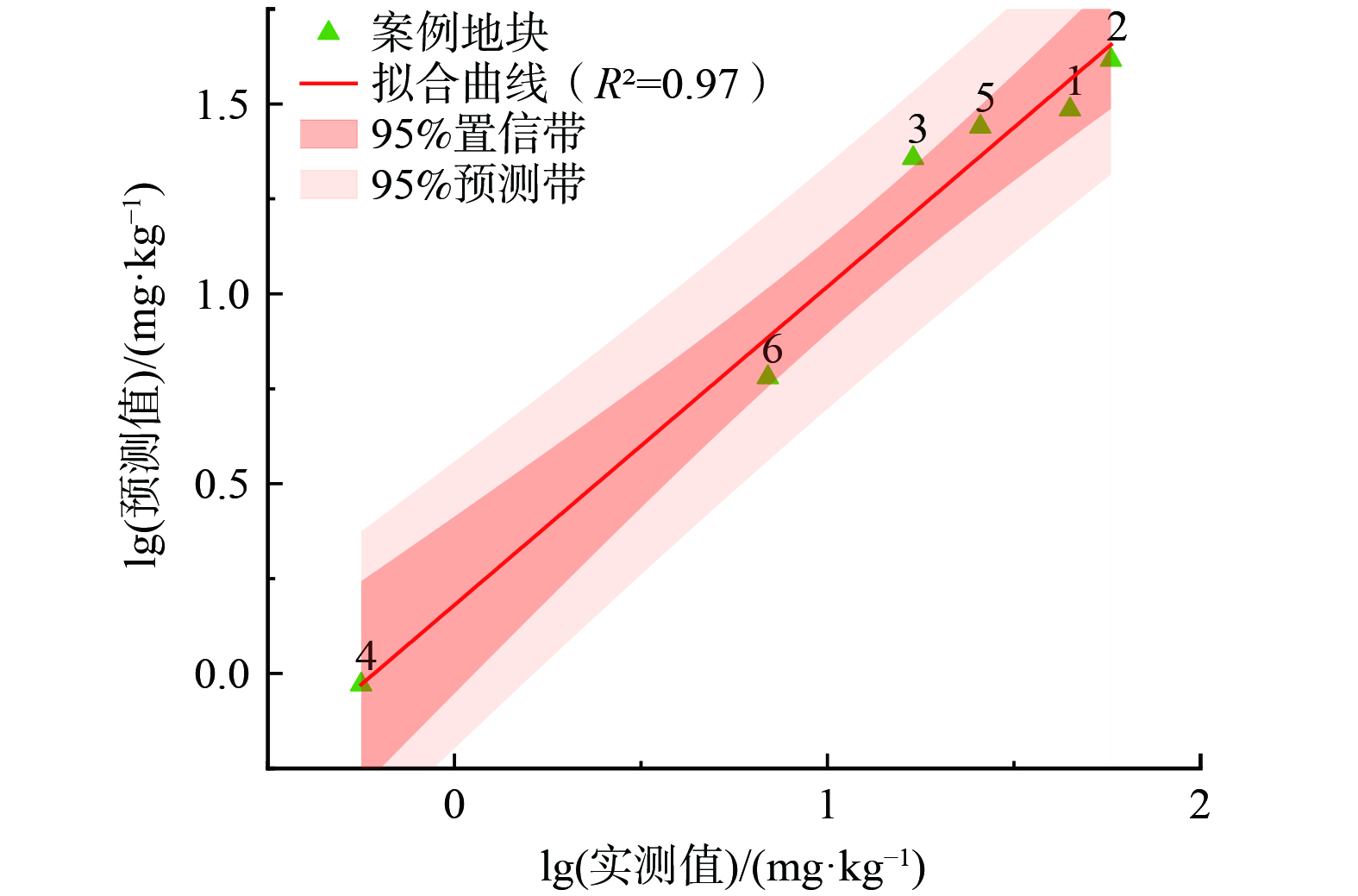-
重金属和多环芳烃是冶炼[1]、钢铁[2]和焦化[3-4]等行业污染地块的主要特征污染物,经口摄入是土壤中重金属和多环芳烃对人体健康产生风险的主要暴露途径[5]。目前我国主要以重金属和多环芳烃的总量计算健康风险[6],但是重金属和多环芳烃随土壤经口摄入人体后,只有部分污染物会经过一系列的过程从土壤中解吸出来进入消化系统和血液循环系统[7-8]。因此基于土壤中重金属和多环芳烃的总量进行风险评估往往过于保守,导致修复目标值过于严格,进而造成过度修复[9-10]。2022年12月28日,生态环境部发布了《建设用地土壤污染修复目标值制定指南 (试行) 》,该指南对土壤中重金属和多环芳烃等以经口摄入为主要暴露途径的污染物建议结合开展生物可给性测试推导土壤污染物的修复目标值[11]。不少研究也基于生物可给性开展风险评估[12-13]。但因生物可给性存在区域性差异,每个污染地块在开展风险评估时均需测定生物可给性,这一过程既耗时,又会增加测试成本。通过探究生物可给性的影响因素,构建可靠的生物可给性预测模型能够有效解决地块开展生物可给性测试导致的成本高和耗时长的问题。
重金属和多环芳烃生物可给性的影响因素包括污染物赋存形态、土壤性质和老化时间等[14-16]。GIROUARD等[17]对加拿大土壤中As的生物可给性进行了研究,结果表明土壤中有机质及粘粒的质量分数与As的生物可给性有很好的相关性;范婧婧[18]研究了焦化场地中PAHs生物可给性的影响,结果显示土壤粘粒质量分数与PAHs生物可给性呈负相关;黄淑婷等[19]研究了无机盐厂中土壤粒径对Cr生物可给性的影响,结果表明粒径大的土壤中Cr的生物可给性较高。李继宁等[20]探究了株洲市某农田土壤中Cr、Cu、Zn、As、Cd和Pb生物可给量与重金属总量、土壤pH和有机质等土壤性质的关系,采用逐步回归法构建了重金属生物可给量预测模型 (R2范围为0.662~0.983) ,但构建模型的数据仅来源于研究区域的农田土壤,预测模型具有局限性;武慧君等[21]利用土壤重金属 (Co、Cr、Cu、Ni、Pb和Zn) 总量、pH和有机质构建了某煤矿型城市小学土壤中重金属生物可给量逐步回归预测模型,预测模型R2为0.006~0.523,只能在一定程度上预测土壤中重金属生物可给量;XIE等[22]采用随机森林回归法,利用重金属赋存形态与土壤理化性质构建了采矿厂和冶炼厂As、Pb和Cd胃相生物可给性的预测模型,预测模型R2为0.70~0.98,表明采用随机森林法能构建可靠的生物可给性预测模型。
国内研究大多采用逐步线性回归法构建可给性预测模型[23-24],该法构建的模型为线性模型,对异常值比较敏感[25],容易造成预测模型欠拟合或过拟合,而随机森林模型容忍多重共线性且容错性高,可以避免这个问题[26],因此被广泛应用于预测植物、土壤和沉积物中重金属[27-28]等方面的研究,但在预测实际污染场地土壤重金属和PAHs生物可给性方面应用较少。本研究以我国东北老工业基地、长三角、西南等区域典型污染地块为研究对象,探究土壤中砷 (As) 和典型多环芳烃苯并[a]芘 (BaP) 的生物可给量、污染物总量与土壤性质的影响规律,并采用逐步回归方法和随机森林回归方法构建生物可给量预测模型,以期为我国污染场地土壤重金属和多环芳烃风险评估工作提供技术支持。
-
通过全国建设用地土壤环境管理信息系统[29]、Web of Science、中国知网等数据库收集污染地块土壤As和BaP的体外试验生物可给性数据和对应的土壤性质数据,包括As和BaP总量、生物可给量,以及土壤pH、阳离子交换量 (CEC) 、土壤有机质 (SOM) 、粒径分布等土壤性质数据。初步筛选了200篇文献和6份风险评估报告,最终选生物可给性测试规范、土壤性质数据详实且研究区域为我国污染地块的12篇论文和3份风险评估报告,其中As污染地块有19个,BaP污染地块有7个。对数据进行预处理,去除异常值,采用基于随机森林的多重插补的方法处理土壤性质存在缺失值问题[30]。
-
首先对As和BaP的生物可给量与总量和各土壤性质之间进行相关性分析,统计分析发现As和BaP的生物可给量与其土壤中总量和土壤理化性质等数据不完全服从正态分布,因此对其进行Spearman相关性分析来评估各因素之间的相关性,显著性水平取P<0. 05和P<0. 01。
-
逐步回归方法能够筛选和识别出主要影响的变量。随机森林回归方法是通过组合多个决策树,最终结果取均值,构建的模型精确度高且泛化能力强。本研究分别采用逐步回归方法和随机森林回归方法构建土壤As和BaP生物可给性预测模型。为了构建可靠的预测模型,对As和BaP生物可给量、总量以及土壤CEC、SOM、粘粒、粉粒和砂粒等非正态分布的数据进行对数转换。通过“statsmodels”包进行构建逐步回归模型,构建随机森林模型步骤如下:①将数据集随机拆分为训练集 (75%) 和测试集 (25%) ;②通过“RandomForestRegressor”包进行建模,并通过“GridSearchCV”包进行网格搜索,调整树的数量、树的最大深度等参数寻找最优参数,同时用该包进行五折交叉验证 (cv=5) ;③根据最优参数进行训练,输入污染物总量和土壤性质数据得到预测的生物可给量。为了更好地理解随机森林回归预测模型,通过计算内置随机森林重要性和SHAP值来描述随机森林回归模型中特征重要性。其中SHAP属于模型事后解释方法,对于每个预测样本,每个特征都有1个SHAP值,它表示特征对该预测样本行为的影响[31]。使用决定系数 (R2) 评估2种预测模型的性能,选择R2高的预测模型进行案例地块验证。
-
为了验证预测模型在实际应用中的可靠性,结合区域地质条件的影响,选取大连化工厂、白银冶炼厂、六盘水冶炼厂、福州冶炼厂、湖南冶炼厂和北京焦化厂6个未用于构建预测模型的典型污染地块,对构建的As和BaP生物可给量预测模型进行验证。这6个地块分别位于我国东北老工业基地、长三角、西南等区域,且影响生物可给量的主要土壤性质SOM、pH等差异较大,具有研究的代表性。
-
使用R 4.2.2软件中的“mice”包进行缺失值处理,使用SPSS 26.0软件进行数据统计分析和相关分析,使用Origin 2021软件实现数据可视化。逐步回归模型和随机森林回归模型的构建使用Python 3.11软件中Scikit-Learn包实现。
-
整理筛选后的12篇文献和3份风险评估报告中的数据,如表1所示。由表可知,As污染地块主要涉及冶炼厂,土壤As总量范围为1.28~15 218 mg·kg−1,As生物可给量范围为0.56~6 088.31 mg·kg−1,其生物可给性测试方法包括PBET、IVG、UBM和SBRC等,生物可给性范围为0.9~89.7%。BaP污染地块主要涉及焦化厂和钢铁厂,土壤BaP的总量范围为1.20~320.1 mg·kg−1,生物可给量范围为0.03~9.13 mg·kg−1,生物可给性范围为1.4%~52.79%,测试方法主要为DIN。土壤性质数据整体情况如图1所示。由图可知,土壤性质分布差异显著,如砂粒 (2.33%~89.17%) 、粉粒 (10.83%~79.80%) 、粘粒 (0~53.5%) 、CEC (0.98~36.18 cmol·kg−1) 、SOM (1.72~343.08 g·kg−1) 。土壤pH 为2.20~10.90。土壤性质的差异为研究As和BaP生物可给性与土壤性质之间关系的提供了基础。
-
采用Spearman相关性分析方法,研究土壤中污染物可给量、污染物总量和土壤性质之间的相关性 (表2) 。由表可知,土壤中As和BaP生物可给量均与总量呈极显著的正相关性 (P<0.01) ,与钟茂生等[42]的研究结论相符。土壤pH也是影响生物可给性的重要因素之一,分析结果显示As和BaP的生物可给量均与pH呈极显著负相关性。CEC与As的生物可给量呈极显著负相关性,这可能是由于土壤CEC增大更容易吸附重金属[43],与CUI等[44]的研究结果一致。此外,粘粒质量分数与BaP生物可给量呈显著负相关,原因可能是土壤粘粒质量分数高,粒径小,比表面积大,更容易吸附污染物,使其生物可给性降低[28]。众多研究表明其他土壤性质也会对生物可给性产生影响,如BaP生物可给性与SOM呈负相关性[45-46],SOM对BaP等亲脂性的高分子量的PAHs吸附能力强,可以使土壤中BaP的生物可给性降低[47]。
-
基于逐步回归方法,对As和BaP生物可给量构建预测模型如式(1)和(2)所示。由回归方程可知,土壤中As和BaP可给量主要由其总量解释。如表3所示,As和BaP可给量训练集预测模型效果较好,R2分别为0.818和0.917。As测试集R2为0.802,但BaP测试集R2仅为0.306,这说明采用逐步回归法构建的BaP生物可给性预测模型对测试集预测结果较差。
式中:BAs表示As的生物可给量,mg·kg−1;TAs表示As的总量,mg·kg−1;BBaP和TBaP同;ω(Sand)表示砂粒质量分数,%;ω(Silt)表示粉粒质量分数,%。
基于随机森林回归法,以土壤性质和总量为输入特征对As和BaP可给量进行预测,采用网格搜索设置最优参数其中As预测模型树的数量为86,其它参数为默认值,BaP预测模型树的数量为31,其它参数为默认值。预测模型如图2所示,由表4可知训练集R2分别为0.961和0.894,均方根误差 (RMSE) 分别为0.158和0.220,测试集R2分别为0.743和0.793,RMSE分别为0.390和0.169,说明采用随机森林回归法构建的生物可给量模型有良好的泛化能力。通过计算内置随机森林重要性和SHAP值来表示随机森林回归模型中特征重要性[48]。如图3所示,As总量特征值高的样本点分布于SHAP值1.0至1.5区间,因此As的总量对预测As生物可给量有正向影响,与相关性分析结果一致,在构建预测模型中起到了关键作用。如图4所示,BaP总量特征值高的样品点分布于SHAP值1.0至1.5区间,说明BaP的总量对预测生物可给量有正向影响,是随机森林回归模型中最重要的特征,pH和粘粒质量分数特征值高的样本点分布于−0.2至0区间,因此pH和粘粒质量分数对BaP生物可给量的预测有负向影响,与相关性分析结果一致。
对2种方法构建的预测模型进行比较,随机森林回归方法构建的As和BaP生物可给量预测模型在训练集和测试集的R2均值高于逐步回归方法构建的预测模型,说明随机森林回归法构建的预测模型在预测结果上更加可靠,且泛化能力好。因此用该方法构建的预测模型进行实际案例验证。
-
选择了大连化工厂、白银冶炼厂、六盘水冶炼厂、福州冶炼厂、湖南冶炼厂和北京焦化厂6个污染地块进行随机森林预测模型的验证,案例地块土壤性质如表5所示。采用最优参数 (As预测模型树的数量为86,BaP预测模型树的数量为31) ,预测案例地块的生物可给量,通过对比模型预测值和实测值,开展随机森林预测模型的案例验证。验证结果如图5所示,除六盘水冶炼厂,其他5个案例地块都在95%置信带内,造成这一差异的原因可能为六盘水冶炼厂的生产时间较其他地块生产时间短,还可能与该地块土壤中铁质量分数较高有关。6个案例地块都在95%预测带内,且拟合曲线R2为0.97,说明随机森林构建的预测模型预测效果较好,在实际地块的应用中可以采用随机森林回归模型对可给量进行预测。
-
1) 分析发现土壤中As和BaP的生物可给量均与总量呈极显著正相关性 (P<0.01) ,与pH呈极显著负相关性,此外As的生物可给量与CEC呈极显著负相关性,BaP生物可给量与粘粒质量分数呈极显著负相关性。
2) 分别采用逐步回归法和随机森林回归法构建As和BaP生物可给量预测模型,比较2种模型训练集和测试集的R2大小,发现随机森林回归模型较逐步回归模型更可靠且泛化能力强。构建的随机森林预测模型的特征重要性与Spearman相关性分析结果一致。
3) 采用随机森林法对案例地块的生物可给量进行预测,结合案例验证结果,As和BaP随机森林回归预测模型对6个典型污染地块的预测效果较好 (R2=0.97) ,说明构建的预测模型适用于我国东北老工业基地、长三角、西南等区域As和BaP污染场地。
污染地块土壤砷与苯并[a]芘生物可给性影响因素研究与模型预测
Effect factors and model prediction of arsenic and benzo[a]pyrene bioaccessibility in the soil of contaminated sites
-
摘要: 利用模型预测生物可给性比现场采样测试获取生物可给性检测结果耗时短、成本低。为探究砷 (As) 和苯并[a]芘 (BaP) 生物可给量与土壤性质之间的关系,统计了12篇文献和3份风险评估报告中As和BaP生物可给性、生物可给量和土壤性质数据,分析了生物可给量与土壤性质之间的关系,并基于逐步回归分析法和随机森林回归法构建了生物可给量的预测模型。结果表明:土壤中As的生物可给量与总量呈极显著正相关 (P<0.01) ,与土壤pH和CEC呈极显著负相关,BaP的生物可给量与总量呈极显著正相关,与土壤pH和粘粒质量分数呈极显著负相关性;分别采用逐步回归法和随机森林回归法构建了As和BaP生物可给量预测模型,综合比较2种模型训练集和测试集的R2大小,发现随机森林回归预测模型对生物可给量的预测结果优于逐步回归预测模型,且随机森林预测模型特征重要性与相关性分析结果一致;采用随机森林回归预测模型进行案例地块验证,验证结果表明,随机森林回归预测模型对6个典型污染地块As和BaP的生物可给量预测效果较好 (R2=0.97) 。研究结果可为重金属和半挥发性有机物污染地块中生物可给性的应用提供技术支持。Abstract: Compared to on-site sampling and testing bioaccessibility, constructing predictive models for bioaccessibility proves to be more cost-effective and time-efficient. To investigate the relationship between the bioaccessibility content of arsenic (As) and benzo[a]pyrene (BaP) and soil properties, this study conducted a statistical analysis of data on As and BaP bioaccessibility, bioaccessibility content, and soil properties from 12 research articles and 3 risk assessment reports. The relationship between bioaccessibility content and soil properties was analyzed . Subsequently, this study constructed predictive models for bioaccessibility content using stepwise regression analysis and random forest regression analysis. The results showed that the bioaccessibility content of As was positively correlated with the total amount, and negatively correlated with soil pH and CEC. The bioaccessibility content of BaP was positively correlated with the total amount, and negatively correlated with soil pH and clay content.Prediction models for the bioaccessibility content of As and BaP were constructed using stepwise regression analysis and random forest regression. Upon comparing the R2 values for training and testing datasets of the two models, it was found that the random forest regression predictive model outperformed the stepwise regression predictive model. The feature importance of random forest prediction model was consistent with the correlation analysis results. Consequently, the random forest regression predictive model was used for site-specific validation, which yielded positive results. The results of cases validation showed that the random forest regression model for As and BaP had good prediction performance for six typical contaminated sites (R2=0.97). The result of this study can provide technical support for the application of bioaccessibility in heavy metal and semi-volatile organic compounds contaminated sites.
-
Key words:
- contaminated site /
- arsenic /
- benzo[a]pyrene /
- bioaccessibility /
- stepwise regression /
- random forest
-
重金属和多环芳烃是冶炼[1]、钢铁[2]和焦化[3-4]等行业污染地块的主要特征污染物,经口摄入是土壤中重金属和多环芳烃对人体健康产生风险的主要暴露途径[5]。目前我国主要以重金属和多环芳烃的总量计算健康风险[6],但是重金属和多环芳烃随土壤经口摄入人体后,只有部分污染物会经过一系列的过程从土壤中解吸出来进入消化系统和血液循环系统[7-8]。因此基于土壤中重金属和多环芳烃的总量进行风险评估往往过于保守,导致修复目标值过于严格,进而造成过度修复[9-10]。2022年12月28日,生态环境部发布了《建设用地土壤污染修复目标值制定指南 (试行) 》,该指南对土壤中重金属和多环芳烃等以经口摄入为主要暴露途径的污染物建议结合开展生物可给性测试推导土壤污染物的修复目标值[11]。不少研究也基于生物可给性开展风险评估[12-13]。但因生物可给性存在区域性差异,每个污染地块在开展风险评估时均需测定生物可给性,这一过程既耗时,又会增加测试成本。通过探究生物可给性的影响因素,构建可靠的生物可给性预测模型能够有效解决地块开展生物可给性测试导致的成本高和耗时长的问题。
重金属和多环芳烃生物可给性的影响因素包括污染物赋存形态、土壤性质和老化时间等[14-16]。GIROUARD等[17]对加拿大土壤中As的生物可给性进行了研究,结果表明土壤中有机质及粘粒的质量分数与As的生物可给性有很好的相关性;范婧婧[18]研究了焦化场地中PAHs生物可给性的影响,结果显示土壤粘粒质量分数与PAHs生物可给性呈负相关;黄淑婷等[19]研究了无机盐厂中土壤粒径对Cr生物可给性的影响,结果表明粒径大的土壤中Cr的生物可给性较高。李继宁等[20]探究了株洲市某农田土壤中Cr、Cu、Zn、As、Cd和Pb生物可给量与重金属总量、土壤pH和有机质等土壤性质的关系,采用逐步回归法构建了重金属生物可给量预测模型 (R2范围为0.662~0.983) ,但构建模型的数据仅来源于研究区域的农田土壤,预测模型具有局限性;武慧君等[21]利用土壤重金属 (Co、Cr、Cu、Ni、Pb和Zn) 总量、pH和有机质构建了某煤矿型城市小学土壤中重金属生物可给量逐步回归预测模型,预测模型R2为0.006~0.523,只能在一定程度上预测土壤中重金属生物可给量;XIE等[22]采用随机森林回归法,利用重金属赋存形态与土壤理化性质构建了采矿厂和冶炼厂As、Pb和Cd胃相生物可给性的预测模型,预测模型R2为0.70~0.98,表明采用随机森林法能构建可靠的生物可给性预测模型。
国内研究大多采用逐步线性回归法构建可给性预测模型[23-24],该法构建的模型为线性模型,对异常值比较敏感[25],容易造成预测模型欠拟合或过拟合,而随机森林模型容忍多重共线性且容错性高,可以避免这个问题[26],因此被广泛应用于预测植物、土壤和沉积物中重金属[27-28]等方面的研究,但在预测实际污染场地土壤重金属和PAHs生物可给性方面应用较少。本研究以我国东北老工业基地、长三角、西南等区域典型污染地块为研究对象,探究土壤中砷 (As) 和典型多环芳烃苯并[a]芘 (BaP) 的生物可给量、污染物总量与土壤性质的影响规律,并采用逐步回归方法和随机森林回归方法构建生物可给量预测模型,以期为我国污染场地土壤重金属和多环芳烃风险评估工作提供技术支持。
1. 材料与方法
1.1 数据获取与处理
通过全国建设用地土壤环境管理信息系统[29]、Web of Science、中国知网等数据库收集污染地块土壤As和BaP的体外试验生物可给性数据和对应的土壤性质数据,包括As和BaP总量、生物可给量,以及土壤pH、阳离子交换量 (CEC) 、土壤有机质 (SOM) 、粒径分布等土壤性质数据。初步筛选了200篇文献和6份风险评估报告,最终选生物可给性测试规范、土壤性质数据详实且研究区域为我国污染地块的12篇论文和3份风险评估报告,其中As污染地块有19个,BaP污染地块有7个。对数据进行预处理,去除异常值,采用基于随机森林的多重插补的方法处理土壤性质存在缺失值问题[30]。
1.2 生物可给量与土壤性质相关性分析
首先对As和BaP的生物可给量与总量和各土壤性质之间进行相关性分析,统计分析发现As和BaP的生物可给量与其土壤中总量和土壤理化性质等数据不完全服从正态分布,因此对其进行Spearman相关性分析来评估各因素之间的相关性,显著性水平取P<0. 05和P<0. 01。
1.3 生物可给量预测模型构建
逐步回归方法能够筛选和识别出主要影响的变量。随机森林回归方法是通过组合多个决策树,最终结果取均值,构建的模型精确度高且泛化能力强。本研究分别采用逐步回归方法和随机森林回归方法构建土壤As和BaP生物可给性预测模型。为了构建可靠的预测模型,对As和BaP生物可给量、总量以及土壤CEC、SOM、粘粒、粉粒和砂粒等非正态分布的数据进行对数转换。通过“statsmodels”包进行构建逐步回归模型,构建随机森林模型步骤如下:①将数据集随机拆分为训练集 (75%) 和测试集 (25%) ;②通过“RandomForestRegressor”包进行建模,并通过“GridSearchCV”包进行网格搜索,调整树的数量、树的最大深度等参数寻找最优参数,同时用该包进行五折交叉验证 (cv=5) ;③根据最优参数进行训练,输入污染物总量和土壤性质数据得到预测的生物可给量。为了更好地理解随机森林回归预测模型,通过计算内置随机森林重要性和SHAP值来描述随机森林回归模型中特征重要性。其中SHAP属于模型事后解释方法,对于每个预测样本,每个特征都有1个SHAP值,它表示特征对该预测样本行为的影响[31]。使用决定系数 (R2) 评估2种预测模型的性能,选择R2高的预测模型进行案例地块验证。
1.4 预测模型案例验证
为了验证预测模型在实际应用中的可靠性,结合区域地质条件的影响,选取大连化工厂、白银冶炼厂、六盘水冶炼厂、福州冶炼厂、湖南冶炼厂和北京焦化厂6个未用于构建预测模型的典型污染地块,对构建的As和BaP生物可给量预测模型进行验证。这6个地块分别位于我国东北老工业基地、长三角、西南等区域,且影响生物可给量的主要土壤性质SOM、pH等差异较大,具有研究的代表性。
1.5 数据处理与分析方法
使用R 4.2.2软件中的“mice”包进行缺失值处理,使用SPSS 26.0软件进行数据统计分析和相关分析,使用Origin 2021软件实现数据可视化。逐步回归模型和随机森林回归模型的构建使用Python 3.11软件中Scikit-Learn包实现。
2. 结果与讨论
2.1 数据集构建
整理筛选后的12篇文献和3份风险评估报告中的数据,如表1所示。由表可知,As污染地块主要涉及冶炼厂,土壤As总量范围为1.28~15 218 mg·kg−1,As生物可给量范围为0.56~6 088.31 mg·kg−1,其生物可给性测试方法包括PBET、IVG、UBM和SBRC等,生物可给性范围为0.9~89.7%。BaP污染地块主要涉及焦化厂和钢铁厂,土壤BaP的总量范围为1.20~320.1 mg·kg−1,生物可给量范围为0.03~9.13 mg·kg−1,生物可给性范围为1.4%~52.79%,测试方法主要为DIN。土壤性质数据整体情况如图1所示。由图可知,土壤性质分布差异显著,如砂粒 (2.33%~89.17%) 、粉粒 (10.83%~79.80%) 、粘粒 (0~53.5%) 、CEC (0.98~36.18 cmol·kg−1) 、SOM (1.72~343.08 g·kg−1) 。土壤pH 为2.20~10.90。土壤性质的差异为研究As和BaP生物可给性与土壤性质之间关系的提供了基础。
表 1 污染地块土壤性质和生物可给量Table 1. Soil properties and bioaccessibility content of contaminated sites污染物 污染地块 样本个数 总量/(mg·kg−1) 测试方法 生物可给量/(mg·kg−1) 数据来源 As 太原冶炼厂 3 5.76~7.61 IVG 0.96~1.24 文献[22] 福州冶炼厂 2 1.28~3.53 IVG 0.56~1.76 六盘水冶炼厂 3 11.50~345.56 IVG 1.41~17.0 太原冶炼厂 3 5.26~9.79 IVG 1.89~2.73 韶关冶炼厂 1 275.01 IVG 40.98 重庆冶炼厂 6 3.50~10.04 IVG 1.14~2.82 湖南锌业公司 2 9.40~79.54 IVG 1.74~22.71 山西冶炼厂 3 10.81~75.73 IVG 2.85~23.81 白银冶炼厂 3 6.13~722.62 IVG 1.78~247.61 大庆钢铁厂 4 11.75~15.66 IVG 4.52~6.16 大连化工厂 1 225.80 PBET 44.26 文献[29] 采矿冶炼厂 11 36.00~4 172.00 IVG 12.30~3 183.24 文献[32] 广州工业区 1 26.00 PBET 6.86 文献[33] 重庆钢铁厂 8 7.00~205.00 PBET 0.85~32.25 文献[34] 湖南采矿冶炼厂 11 28~15 218.00 UBM 0.95~495.52 文献[35] 石门采矿厂 20 7.40~96.60 PBET 2.96~49.81 文献[36] 衡阳冶炼厂 1 107.48 SBRC 96.41 文献[37] 湖南冶炼厂 1 7 063.00 PBET 6 088.31 文献[38] 某工业园区 3 5.94~10.28 IVG 4.25~7.31 文献[39] BaP 河北焦化厂 13 8.21~21.41 DIN 4.00~9.13 文献[40] 北京焦化厂 1 320.10 DIN 6.40 文献[18,41] 山东钢铁厂 1 88.90 DIN 6.05 北京钢铁厂 1 46.60 DIN 6.89 大连农药厂 1 1.20 DIN 0.48 重庆焦化厂 1 2.10 DIN 0.03 文献[29] 昆明钢铁厂 8 3.40~15.45 DIN 0.13~2.87 2.2 生物可给量相关性分析
采用Spearman相关性分析方法,研究土壤中污染物可给量、污染物总量和土壤性质之间的相关性 (表2) 。由表可知,土壤中As和BaP生物可给量均与总量呈极显著的正相关性 (P<0.01) ,与钟茂生等[42]的研究结论相符。土壤pH也是影响生物可给性的重要因素之一,分析结果显示As和BaP的生物可给量均与pH呈极显著负相关性。CEC与As的生物可给量呈极显著负相关性,这可能是由于土壤CEC增大更容易吸附重金属[43],与CUI等[44]的研究结果一致。此外,粘粒质量分数与BaP生物可给量呈显著负相关,原因可能是土壤粘粒质量分数高,粒径小,比表面积大,更容易吸附污染物,使其生物可给性降低[28]。众多研究表明其他土壤性质也会对生物可给性产生影响,如BaP生物可给性与SOM呈负相关性[45-46],SOM对BaP等亲脂性的高分子量的PAHs吸附能力强,可以使土壤中BaP的生物可给性降低[47]。
表 2 As和BaP生物可给性与总量和土壤性质之间相关性Table 2. Correlation between As and BaP bioaccessibility and total amount and soil properties考察项目 As生物可给量 BaP生物可给量 污染物总量 0.888** 0.868** pH −0.295** −0.612** 有机质 0.102 0.009 CEC −0.277** 0.222 粘粒 0.113 −0.498** 粉粒 −0.104 0.347 砂砾 0.046 0.257 注:**、*分别代表1%、5%的显著性水平。 2.3 生物可给量预测模型构建
基于逐步回归方法,对As和BaP生物可给量构建预测模型如式(1)和(2)所示。由回归方程可知,土壤中As和BaP可给量主要由其总量解释。如表3所示,As和BaP可给量训练集预测模型效果较好,R2分别为0.818和0.917。As测试集R2为0.802,但BaP测试集R2仅为0.306,这说明采用逐步回归法构建的BaP生物可给性预测模型对测试集预测结果较差。
表 3 As和BaP生物可给性逐步回归模型性能Table 3. Stepwise regression models performance for bioaccessibility content of As and BaP污染物 训练集R2 测试集R2 As 0.818 0.802 BaP 0.917 0.306 stringUtils.convertMath(!{formula.content}) (1) stringUtils.convertMath(!{formula.content}) (2) 式中:BAs表示As的生物可给量,mg·kg−1;TAs表示As的总量,mg·kg−1;BBaP和TBaP同;ω(Sand)表示砂粒质量分数,%;ω(Silt)表示粉粒质量分数,%。
基于随机森林回归法,以土壤性质和总量为输入特征对As和BaP可给量进行预测,采用网格搜索设置最优参数其中As预测模型树的数量为86,其它参数为默认值,BaP预测模型树的数量为31,其它参数为默认值。预测模型如图2所示,由表4可知训练集R2分别为0.961和0.894,均方根误差 (RMSE) 分别为0.158和0.220,测试集R2分别为0.743和0.793,RMSE分别为0.390和0.169,说明采用随机森林回归法构建的生物可给量模型有良好的泛化能力。通过计算内置随机森林重要性和SHAP值来表示随机森林回归模型中特征重要性[48]。如图3所示,As总量特征值高的样本点分布于SHAP值1.0至1.5区间,因此As的总量对预测As生物可给量有正向影响,与相关性分析结果一致,在构建预测模型中起到了关键作用。如图4所示,BaP总量特征值高的样品点分布于SHAP值1.0至1.5区间,说明BaP的总量对预测生物可给量有正向影响,是随机森林回归模型中最重要的特征,pH和粘粒质量分数特征值高的样本点分布于−0.2至0区间,因此pH和粘粒质量分数对BaP生物可给量的预测有负向影响,与相关性分析结果一致。
表 4 As和BaP随机森林预测模型评价指标Table 4. Evaluation index of random forest prediction model As and BaP污染物 训练集R2 训练集RMSE 测试集R2 测试集RMSE As 0.961 0.158 0.743 0.390 BaP 0.894 0.220 0.793 0.169 对2种方法构建的预测模型进行比较,随机森林回归方法构建的As和BaP生物可给量预测模型在训练集和测试集的R2均值高于逐步回归方法构建的预测模型,说明随机森林回归法构建的预测模型在预测结果上更加可靠,且泛化能力好。因此用该方法构建的预测模型进行实际案例验证。
2.4 案例验证
选择了大连化工厂、白银冶炼厂、六盘水冶炼厂、福州冶炼厂、湖南冶炼厂和北京焦化厂6个污染地块进行随机森林预测模型的验证,案例地块土壤性质如表5所示。采用最优参数 (As预测模型树的数量为86,BaP预测模型树的数量为31) ,预测案例地块的生物可给量,通过对比模型预测值和实测值,开展随机森林预测模型的案例验证。验证结果如图5所示,除六盘水冶炼厂,其他5个案例地块都在95%置信带内,造成这一差异的原因可能为六盘水冶炼厂的生产时间较其他地块生产时间短,还可能与该地块土壤中铁质量分数较高有关。6个案例地块都在95%预测带内,且拟合曲线R2为0.97,说明随机森林构建的预测模型预测效果较好,在实际地块的应用中可以采用随机森林回归模型对可给量进行预测。
表 5 案例地块土壤性质数据Table 5. Soil properties data of contaminated plot序号 案例地块 污染物 总量/(mg·kg−1) pH SOM/(g·kg−1) CEC/(cmol·kg−1) 粘粒/% 粉粒/% 砂粒/% 1 大连化工厂 As 225.80 8.17 231.02 5.30 11.00 72.00 17.00 2 白银冶炼厂 169.36 6.23 52.58 5.20 5.62 74.08 20.30 3 六盘水冶炼厂 345.56 7.21 121.54 10.00 44.43 25.16 30.41 4 福州冶炼厂 1.28 9.29 1.72 4.02 3.41 60.00 36.59 5 湖南冶炼厂 280.00 7.66 16.38 9.02 37.00 57.80 5.18 6 北京焦化厂 BaP 46.60 7.71 23.20 8.10 1.95 17.06 80.99 3. 结论
1) 分析发现土壤中As和BaP的生物可给量均与总量呈极显著正相关性 (P<0.01) ,与pH呈极显著负相关性,此外As的生物可给量与CEC呈极显著负相关性,BaP生物可给量与粘粒质量分数呈极显著负相关性。
2) 分别采用逐步回归法和随机森林回归法构建As和BaP生物可给量预测模型,比较2种模型训练集和测试集的R2大小,发现随机森林回归模型较逐步回归模型更可靠且泛化能力强。构建的随机森林预测模型的特征重要性与Spearman相关性分析结果一致。
3) 采用随机森林法对案例地块的生物可给量进行预测,结合案例验证结果,As和BaP随机森林回归预测模型对6个典型污染地块的预测效果较好 (R2=0.97) ,说明构建的预测模型适用于我国东北老工业基地、长三角、西南等区域As和BaP污染场地。
-
表 1 污染地块土壤性质和生物可给量
Table 1. Soil properties and bioaccessibility content of contaminated sites
污染物 污染地块 样本个数 总量/(mg·kg−1) 测试方法 生物可给量/(mg·kg−1) 数据来源 As 太原冶炼厂 3 5.76~7.61 IVG 0.96~1.24 文献[22] 福州冶炼厂 2 1.28~3.53 IVG 0.56~1.76 六盘水冶炼厂 3 11.50~345.56 IVG 1.41~17.0 太原冶炼厂 3 5.26~9.79 IVG 1.89~2.73 韶关冶炼厂 1 275.01 IVG 40.98 重庆冶炼厂 6 3.50~10.04 IVG 1.14~2.82 湖南锌业公司 2 9.40~79.54 IVG 1.74~22.71 山西冶炼厂 3 10.81~75.73 IVG 2.85~23.81 白银冶炼厂 3 6.13~722.62 IVG 1.78~247.61 大庆钢铁厂 4 11.75~15.66 IVG 4.52~6.16 大连化工厂 1 225.80 PBET 44.26 文献[29] 采矿冶炼厂 11 36.00~4 172.00 IVG 12.30~3 183.24 文献[32] 广州工业区 1 26.00 PBET 6.86 文献[33] 重庆钢铁厂 8 7.00~205.00 PBET 0.85~32.25 文献[34] 湖南采矿冶炼厂 11 28~15 218.00 UBM 0.95~495.52 文献[35] 石门采矿厂 20 7.40~96.60 PBET 2.96~49.81 文献[36] 衡阳冶炼厂 1 107.48 SBRC 96.41 文献[37] 湖南冶炼厂 1 7 063.00 PBET 6 088.31 文献[38] 某工业园区 3 5.94~10.28 IVG 4.25~7.31 文献[39] BaP 河北焦化厂 13 8.21~21.41 DIN 4.00~9.13 文献[40] 北京焦化厂 1 320.10 DIN 6.40 文献[18,41] 山东钢铁厂 1 88.90 DIN 6.05 北京钢铁厂 1 46.60 DIN 6.89 大连农药厂 1 1.20 DIN 0.48 重庆焦化厂 1 2.10 DIN 0.03 文献[29] 昆明钢铁厂 8 3.40~15.45 DIN 0.13~2.87 表 2 As和BaP生物可给性与总量和土壤性质之间相关性
Table 2. Correlation between As and BaP bioaccessibility and total amount and soil properties
考察项目 As生物可给量 BaP生物可给量 污染物总量 0.888** 0.868** pH −0.295** −0.612** 有机质 0.102 0.009 CEC −0.277** 0.222 粘粒 0.113 −0.498** 粉粒 −0.104 0.347 砂砾 0.046 0.257 注:**、*分别代表1%、5%的显著性水平。 表 3 As和BaP生物可给性逐步回归模型性能
Table 3. Stepwise regression models performance for bioaccessibility content of As and BaP
污染物 训练集R2 测试集R2 As 0.818 0.802 BaP 0.917 0.306 表 4 As和BaP随机森林预测模型评价指标
Table 4. Evaluation index of random forest prediction model As and BaP
污染物 训练集R2 训练集RMSE 测试集R2 测试集RMSE As 0.961 0.158 0.743 0.390 BaP 0.894 0.220 0.793 0.169 表 5 案例地块土壤性质数据
Table 5. Soil properties data of contaminated plot
序号 案例地块 污染物 总量/(mg·kg−1) pH SOM/(g·kg−1) CEC/(cmol·kg−1) 粘粒/% 粉粒/% 砂粒/% 1 大连化工厂 As 225.80 8.17 231.02 5.30 11.00 72.00 17.00 2 白银冶炼厂 169.36 6.23 52.58 5.20 5.62 74.08 20.30 3 六盘水冶炼厂 345.56 7.21 121.54 10.00 44.43 25.16 30.41 4 福州冶炼厂 1.28 9.29 1.72 4.02 3.41 60.00 36.59 5 湖南冶炼厂 280.00 7.66 16.38 9.02 37.00 57.80 5.18 6 北京焦化厂 BaP 46.60 7.71 23.20 8.10 1.95 17.06 80.99 -
[1] LI C X, LI M, ZENG J Q, et al. Migration and distribution characteristics of soil heavy metal (loid) s at a lead smelting site[J]. Journal of Environmental Sciences, 2024, 135: 600-609. doi: 10.1016/j.jes.2023.02.007 [2] 张施阳. 钢铁厂遗留场地土壤重金属和多环芳烃的污染特征及健康风险评价[J]. 环境污染与防治, 2022, 44(10): 1336-1342. [3] CAO S Z, DUAN X L, ZHAO X G, et al. Health risks from the exposure of children to As, Se, Pb and other heavy metals near the largest coking plant in China[J]. Science of the Total Environment, 2014, 472: 1001-1009. doi: 10.1016/j.scitotenv.2013.11.124 [4] 贾晓洋, 姜林, 夏天翔, 等. 焦化厂土壤中PAHs的累积、垂向分布特征及来源分析[J]. 化工学报, 2011, 62(12): 3525-3531. [5] CHRISTIAN G, AGNES O, ERIC W, et al. Bioaccessibility of PAH from Danish soils[J]. Journal of Environmental Science and Health Part A, 2007, 42(9): 1233-1239. doi: 10.1080/10934520701435619 [6] 中华人民共和国生态环境部. 建设用地土壤污染风险评估技术导则: HJ 25.3—2019[S]. 北京: 中国环境科学出版社, 2019. [7] Alexander M. Aging, bioavailability, and overestimationof risk from environmental pollutants[J]. Environmental Science& Technology, 2000, 34(20): 4259-4265. [8] EOM I C, RAST C, VEBER A M, et al. Ecotoxicity of a polycyclic aromatic hydrocarbon (PAH) contaminated soil[J]. Ecotoxicology and Environmental Safety, 2007, 67(2): 190-205. doi: 10.1016/j.ecoenv.2006.12.020 [9] 陈卓, 张丹, 吴志远, 等. 基于形态及生物可给性的汞污染场地概率风险[J]. 环境科学研究, 2021, 34(11): 2748-2756. [10] 姜林, 钟茂生, 张丹, 等. 污染场地土壤多环芳烃 (PAHs) 生物可利用浓度的健康风险评价方法[J]. 生态环境学报, 2011, 20(Z1): 1168-1175. [11] 中华人民共和国生态环境部. 建设用地土壤污染修复目标值制定指南 (试行) [EB/OL]. [2022-12-28]. https://www.mee.gov.cn/xxgk2018/xxgk/xxgk06/202212/W020221228543185584361.pdf, 2022. [12] 李慧, 韩雅静, 朱晓辉, 等. 基于生物可给性的农用地土壤重金属复合污染非致癌健康风险评估[J]. 环境科学研究, 2023, 36(4): 783-793. [13] 李小娟, 徐佳燕, 张剑宇, 等. 利用in vitro试验的城市土壤重金属健康风险研究及其对中国土壤污染调查的启示[J]. 天津大学学报 (自然科学与工程技术版) , 2020, 53(10): 1001-1012. [14] 陈晓晨, 韩泽亮, 张剑宇, 等. 中国典型土壤中铅的生物可给性的影响因素分析与健康风险评估[J]. 生态环境学报, 2021, 30(1): 165-172. [15] LU M J, LI G Y, YANG Y, et al. A review on in-vitro oral bioaccessibility of organic pollutants and its application in human exposure assessment[J]. Science of the Total Environment, 2021, 752: 142001. doi: 10.1016/j.scitotenv.2020.142001 [16] YU L B, DUAN L C, NAIDU R, et al. Abiotic factors controlling bioavailability and bioaccessibility of polycyclic aromatic hydrocarbons in soil: Putting together a bigger picture[J]. Science of the Total Environment, 2018, 613-614: 1140-1153. doi: 10.1016/j.scitotenv.2017.09.025 [17] GIROUARD E, ZAGURY G J. Arsenic bioaccessibility in CCA-contaminated soils: Influence of soil properties, arsenic frac-tionation, and particle-size fraction[J]. Science of the Total Environment, 2009, 407(8): 2576-2585. doi: 10.1016/j.scitotenv.2008.12.019 [18] 范婧婧. 基于生物可给性的场地重金属及半挥发有机污染物健康风险评估研究[D]. 河北师范大学, 2020: 36-37. [19] 黄淑婷, 肖荣波, 黄飞, 等. 土壤不同粒级中Cr (Ⅵ) 生物可给性及健康风险[J]. 生态毒理学报, 2023, 18(1): 405-414. [20] 李继宁, 侯红, 魏源, 等. 株洲市农田土壤重金属生物可给性及其人体健康风险评估[J]. 环境科学研究, 2013, 26(10): 1139-1146. [21] 武慧君, 方凤满, 武家园, 等. 煤矿型城市小学校园表层土壤重金属生物可给性与健康风险研究[J]. 土壤通报, 2017, 48(5): 1247-1255. [22] XIE K, XIE N, LIAO Z, et al. Bioaccessibility of arsenic, lead, and cadmium in contaminated mining/smelting soils: Assessment, modeling, and application for soil environment criteria derivation[J]. Journal of Hazardous Materials, 2023, 443 (Pt B) : 130321. [23] 张加文, 田彪, 罗晶晶, 等. 土壤重金属生物可利用性影响因素及模型预测[J]. 环境科学, 2022, 43(7): 3811-3824. [24] LUO X S, YU S, LI X D. The mobility, bioavailability, and human bioaccessibility of trace metals in urban soils of Hong Kong[J]. Applied Geochemistry, 2012, 27(5): 995-1004. doi: 10.1016/j.apgeochem.2011.07.001 [25] 高晓红, 李兴奇. 多元线性回归模型中无量纲化方法比较[J]. 统计与决策, 2022, 38(6): 5-9. [26] BETHANY M, ARKO L, JAGANNATH A. Object-based random forest classification of Landsat ETM+and WorldView-2 satellite imagery for mapping lowland native grassland communities in Tasmania, Australia[J]. International Journal of Applied Earth Observation and Geoinformation, 2018, 66: 46-55. doi: 10.1016/j.jag.2017.11.006 [27] HUANG B Y, LU Q X, TANG Z X, et al. Machine learning methods to predict cadmium (Cd) concentration in rice grainand support soil management at a regional scale[J/OL]. Fundamental Research[2023-3-10].https: //www.sciencedirect.com/science/article/pii/S2667325823000663. [28] YANG H R, HUANG K, ZHANG K, et al. Predicting heavy metal adsorption on soil with machine learning and mapping global distribution of soil adsorption capacities[J]. Environmental Science & Technology, 2021, 55(20): 14316-14328. [29] 生态环境部. 全国建设用地土壤环境管理信息系统[EB/OL]. http: //114.251.10.109/page/shareuserlogin.html. [30] 张逸飞, 曹佳. 土壤属性数据pH缺失的插补方法[J]. 计算机系统应用, 2021, 30(1): 277-281. [31] MENG Y, YANG N H, QIAN Z L, et al. What makes an online review more helpful: An interpretation framework using XGBoost and SHAP values[J]. Theoretical Applied Electronic Commerce, 2021, 16: 466-490. [32] LI S W, LI J, LI H B, et al. Arsenic bioaccessibility in contaminated soils: Coupling in vitro assays with sequential and HNO3 extraction[J]. Journal of Hazardous Materials, 2015, 295: 145-152. doi: 10.1016/j.jhazmat.2015.04.011 [33] LU Y, YIN W, HUANG L, et al. Assessment of bioaccessibility and exposure risk of arsenic and lead in urban soils of Guangzhou City, China[J]. Environmental Geochemistry and Health, 2011, 33: 93-102. doi: 10.1007/s10653-010-9324-8 [34] 张玉, 熊杰, 唐翠梅, 等. 某污染场地土壤重金属生物可给性及其对修复目标的影响研究[J]. 中国氯碱, 2019(6): 41-47. [35] ZHU X, LI M Y, CHEN X Q, et al. As, Cd, and Pb relative bioavailability in contaminated soils: Coupling mouse bioassay with UBM assay[J]. Environment International, 2019, 130: 104875. doi: 10.1016/j.envint.2019.05.069 [36] XIAO W W, LIN G B, HE X M, et al. Interactions among heavy metal bioaccessibility, soil properties and microbial community in phyto-remediated soils nearby an abandoned realgar mine[J]. Chemosphere, 2022, 286: 131638. doi: 10.1016/j.chemosphere.2021.131638 [37] LIAO Q, HE L X, TU G Y, et al. Simultaneous immobilization of Pb, Cd and As in soil by hybrid iron-, sulfate- and phosphate-based bio-nanocomposite: Effectiveness, longterm stability and bioavailablity/bioaccessibility evaluation[J]. Chemosphere, 2021, 266: 128960. doi: 10.1016/j.chemosphere.2020.128960 [38] 冯康宏, 范缙, Lik Ung Stanley Hii, 等. 基于生物可给性的某冶炼厂土壤重金属健康风险评价[J]. 中国环境科学, 2021, 41(1): 442-450. [39] 陈奕. 基于生物可给性分析工业场地土壤重金属污染的人体健康风险[J]. 生态毒理学报, 2020, 15(5): 319-326. [40] 郭晓欣, 范婧婧, 周友亚, 等. 焦化场地典型多环芳烃类污染物精细化风险评估[J]. 生态毒理学报, 2021, 16(1): 155-164. [41] 范婧婧, 周友亚, 王淑萍, 等. 基于DIN测试的场地土壤PAHs生物可给性及健康风险研究[J]. 环境科学研究, 2020, 33(11): 2629-2638. [42] 钟茂生, 彭超, 姜林, 等. 老化土壤中As的人体可给性控制因素及健康风险[J]. 环境科学研究, 2015, 28(2): 267-274. [43] ELBANA T A, SELIM H M, AKRAMI N, et al. Freundlich sorption parameters for cadmium, copper, nickel, lead, and zinc for different soils: Influence of kinetics[J]. Geoderma, 2018, 324: 80-88. doi: 10.1016/j.geoderma.2018.03.019 [44] CUI Y S, CHEN X C. Lead (Pb) and arsenic (As) bioaccessibility in various soils from South China[J]. Environmental Monitoring and Assessment, 2011, 177(1/2/3/4): 481-492. [45] PORTET-KOLTALO F, GARDES T, DEBRET M, et al. Bioaccessibility of polycyclic aromatic compounds (PAHs, PCBs) and trace elements: Influencing factors and determination in a river sediment core[J]. Journal of Hazardous Materials, 2020, 384: 121499. doi: 10.1016/j.jhazmat.2019.121499 [46] CRAMPON M, BODILIS J, LE DERF F, et al. Alternative techniques to HPCD to evaluate the bioaccessible fraction of soil-associated PAHs and correlation to biodegradation efficiency[J]. Journal of Hazardous Materials, 2016, 314: 220-229. doi: 10.1016/j.jhazmat.2016.04.059 [47] CELIS R, DE JONGE H, DE JONGE LW, et al. The role of mineral and organic components in phenanthrene and dibenzofuran sorption by soil[J]. European Journal of Soil Science, 2006, 57: 308-19. doi: 10.1111/j.1365-2389.2005.00740.x [48] GU J J, YANG B, BRAUER M, et al. Enhancing the evaluation and interpretability of data-driven air quality models[J]. Atmospheric Environment, 2021, 246: 118125. doi: 10.1016/j.atmosenv.2020.118125 期刊类型引用(1)
1. 赵美姿,封雪,赵吉睿,李炜. 基于重点行业企业的重点源强评估方法体系构建及应用. 有色金属(冶炼部分). 2024(12): 87-98 .  百度学术
百度学术
其他类型引用(1)
-






 DownLoad:
DownLoad:






